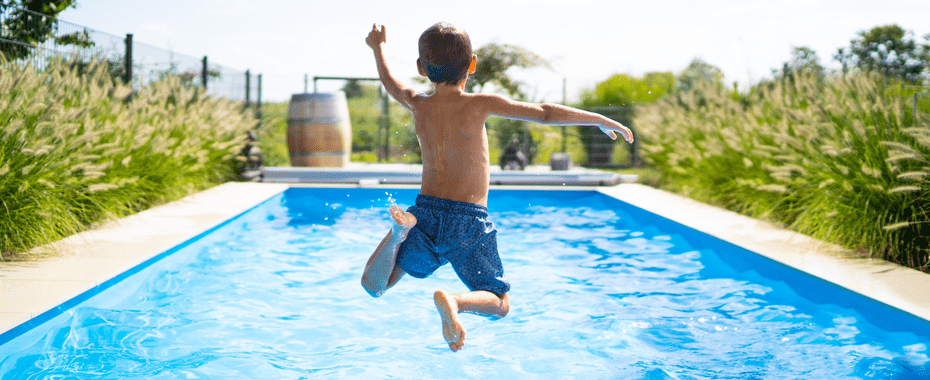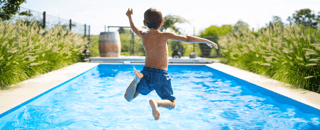Reopening your pool after winter: A how-to guide
If you think you’re ready, here’s how to open a pool after winter.

Key tips to remember
- When do you open your pool? Memorial Day, so plan ahead!
- Be sure to give yourself more time than you think you’ll need.
- Assemble all your safety gear, supplies and chemicals first.
- Realize you’ll need to test multiple factors, multiple times.
- Never skimp on safety, and always call a pro if you need one.
It’s almost pool season! Before you start thinking about cleaning up your pool, check out these 25 beautiful swimming pool ideas to get you in the mood. Looking forward to that glorious time when pools reopen and sunshine is plentiful? Then you’re probably thinking about when to open your pool. Most pools are open between Memorial Day and Labor Day. This schedule isn’t always perfectly in tune with the weather, but it’s a good rule of thumb and easy to remember. You’re probably also wondering, “What do you need to open a pool?” We’ll answer these questions in the following post, so if your mind is on pool reopening and how to open a pool after winter, you’re in the right place. Whether you’re wondering if home warranties cover pools or prefer a more DIY approach, we’ll help prepare you for both scenarios.
When to begin
After what you suspect to be the final freeze — the last gasp of Old Man Winter — is a good time to organize the annual coming-out party for your beloved outdoor pool. Late spring is the perfect time to gather all the supplies, tools and additives you will need to get your pool going again in time for Memorial Day. Don’t wait much longer because you want to beat the algae blooms.
What you might need
Do everyone a favor and take safety seriously. Do you want to be one of the many thousands of people who end up in an emergency room after being poisoned by pool chemicals just because you didn’t practice safe handling methods and use protective gear? Or do you want to have a guest experience a bad reaction to improperly treated water? We didn’t think so. It’s no joke, so ignore this section at your peril. Depending on what items you already have, you might also need:
- Safety goggles
- Chemical gloves
- Friend for help
- Soft broom
- Pool brush
- Pool skimmer
- Telescoping pole
- Garden hose
- Hose filter
- Teflon tape
- pH testing strips
- pH increaser
- pH decreaser
- O-rings
- Gasket lubricant
- Cover cleaner
- Cover pump
- Chlorine
- Chemical kit
- Pool shock
- Metal sequestrant
- Alkalinity increaser
- Water clarifier
- Algaecide
- Calcium hardness increaser
Draining, cleaning and storing the cover
Sweep off any standing debris with a broom, and use the cover pump to remove any dirty standing water from atop your pool cover — you don’t want it to escape into the pool if you can help it. Clean the cover thoroughly with the specified cover cleaner or use car soap, allow it to dry, and then treat it with the alkalinity increaser. Get help from your friend to remove it, fold it, and store it in a cool, dry place. Ideally, keep the cover in a sealed container, but never on the ground or floor of a shed or garage. Be careful not to damage it because you’ll need it again at the end of pool season.
Cleaning the pool
Now you’re ready to grab any leftover sticks, leaves, insects or other debris that may have made its way into the pool despite the cover. Break out the pool brush for the walls and floor; take some extra time to remove any stains you encounter, and then move on to vacuum any leftover debris in the pool, leaving it as clean and pristine as you can for a new season.
Refilling the water
If you left water in the pool instead of draining it for the cold season, you probably lowered the water level below the skimmer. In this case, bring the water level back up to the halfway mark on your tile or to approximately the midpoint of the skimmer. Though evaporation of a few inches can still occur underneath a cover over the winter, if your water level appears significantly lower than when you covered it, you may have to address a leak problem, which will likely require professional help. Whether you need to refill an empty pool or just top it off, restore your water level to normal before using any chemicals or filtering (more on this later). If you refill with a garden hose, use a hose filter to keep out extra metals and minerals. You can also use a metal sequestrant later.
Checking the filter and pump
You’ll want to check the O-rings in the pump and replace them as needed using lubricant. Test the pump to make sure it works, with water circulating and pressure registering on the gauge. If you lack either, you may have a suction-valve leak or a broken gauge. Make sure all the connections are tight. If your gauge spikes, turn off the pump and look for blockages. Check that your return-side valves are open, or switch the multiport valves to waste settings and replace the sight glass and air bleeder along with the gauge. Switch the circuit breaker and prime the pump with water flowing through it. Now switch the multiport valve, if you have one, to the filter setting. If you still have a pump problem, you may need professional help.
Changing the plugs
At this point, you should be ready to remove your winterizing drain plugs, reconnect return valve fittings and reinstall regular drain plugs, using lubricated new O-rings and fresh Teflon tape. If you have a cartridge filter, you can extract antifreeze with a wet-dry shop vacuum on the skimmer line. If you have a sand filter, you can push antifreeze into the waste line by adjusting the multiport valve to the waste setting. However, if you used the right type of nontoxic antifreeze in the first place, you can leave it in place and use the pool without these steps.
Reconnecting remaining components
Now you’re ready to reconnect the pump, filter, heater and auto-vacuum (if you have them). Change any remaining old seals and O-rings, and make sure to lubricate them as necessary. Prime the pump, and turn on circulation and filtration systems; don’t forget to open the filtration system’s air-relief valve to bleed old air bubbles. Go ahead and reattach any ladders, diving boards, handrails, step rails, slides and any other accessories you stored away for winter. Be sure to grease any moving hinges and lubricate bolts to keep things running smoothly.
Balancing the water
After running your pool’s circulation system for a couple of days, you’re ready for the fun part of your pool reopening: balancing the water chemistry! Whether or not chemistry is something you consider a good time, it’s an essential step that must not be shortchanged or overlooked. Before anyone jumps in, you need to make sure that your water is safe for swimming. This means testing its total alkalinity (80 to 120 ppm), pH level (7.4 to 7.6, using test strips), chlorine (2.0 to 4.0 ppm), calcium hardness (150-plus ppm; test this one day later) and stabilizer levels, in that order. You can use a pool testing kit at home or bring a water sample to a pool store for a test. If you must adjust any of these levels, wait at least four hours before testing again. Only add chemicals if you are certain you need them to balance the water.
Shocking the water
Shocking the pool water is the last step toward killing any remaining bacteria and making the water safe for swimmers. Be sure to follow all instructions and use your safety gear! You need approximately 2 pounds of shock for every 10,000 gallons of water. After adding the shock directly to the pool water (not the filter), run the circulation system for a two-hour minimum, then add algaecide. If you use a bucket, make sure it’s exclusive to one chemical. Be safe!
Final filtering
By now, you’re so close to your pool reopening that you can literally smell it. Run the filtration system for a couple of days before planning that Memorial Day pool party. By this time, your water should sparkle like glass after all the shock has dispersed throughout the system. Adding a final dose of clarifier to the water is up to you, but if you give your system the time to circulate all the chemicals you’ve added before swimming, your water should be perfectly clear.
Before you swim
Your pool reopening is almost complete! Your final steps now include storing all your chemicals safely away from children, pets and the elements in a cool, dry place; testing all your safety components around the pool area, like gates and alarms; making final chlorine and pH tests to verify everything is just right; and spraying the deck around the pool, aiming away from the water to clear any residual chemical residue away from swimmers. Remember, you can always call a professional for help if you need one. While you’re here, you may also be interested in our post on swimming pool maintenance. Thanks for stopping by!
The information in this article is intended to provide guidance on the proper maintenance and care of systems and appliances in the home. Not all of the topics mentioned are covered by our home warranty or maintenance plans. Please review your home warranty contract carefully to understand your coverage.
